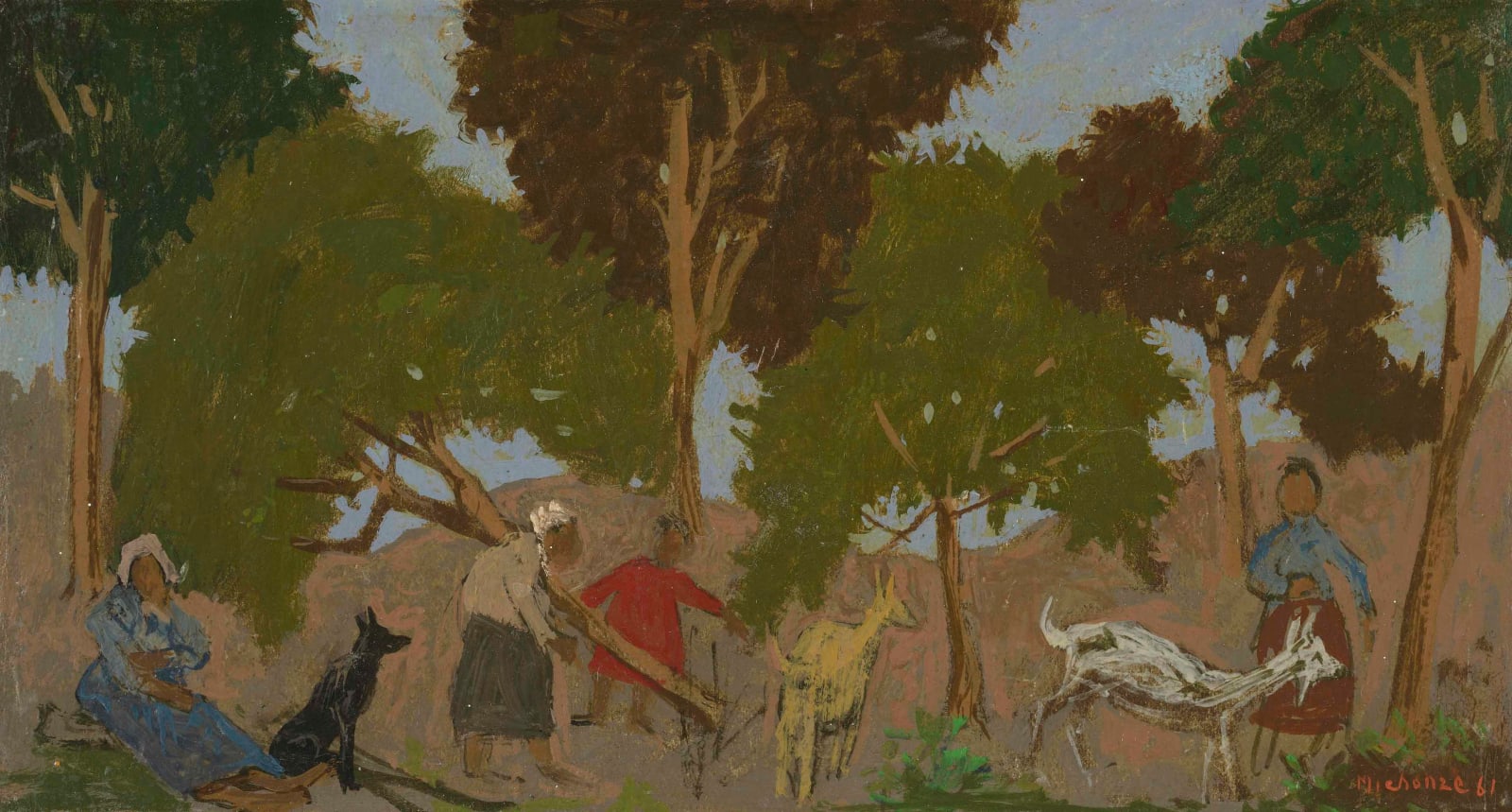Grégoire Michonze (1902 - 1982)
Composition aux chèvres, 1961
Signed and dated 'Michonze 61' (lower right)
Oil on paper laid on canvas
4.75 x 8.5ins (12 x 21.5cm) (artwork size)
5.91 x 9.65ins (15 x 24.5cm) (framed size)
5.91 x 9.65ins (15 x 24.5cm) (framed size)
Copyright The Artist
Currency:
Further images
Gregoire Michonze was born in the Russian Empire in 1902 in Kishinev, today the capital of the Republic of Moldova. After studying art at a local art academy and attending...
Gregoire Michonze was born in the Russian Empire in 1902 in Kishinev, today the capital of the Republic of Moldova. After studying art at a local art academy and attending the Academy of Painting in Bucharest, Michonze decided to pursue an artistic career in Paris. In the 1920s, the city of lights had become an important art scene, attracting artists and intellectuals from all parts of Europe. In Paris, Michonze met Max Ernst, who introduced him to the circle of surrealist artists such as André Breton, Paul Éluard and Louis Aragon. The artist became very close to them, although being never an official member of their group. An independent individual, he developed his own style from the 1930s that he named, with a touch of humour, ‘surreal naturalism’.
Politically engaged, Michonze joined the French artillery in 1939, and was imprisoned in Germany for two years. From this traumatic experience, Michonze made a series of drawings and watercolours, sold to benefit war prisoners' families.
After the war, supported by his wife Una, Michonze was more than ever committed in his art. Participating in many group exhibitions, he had his first solo show in Paris in 1953 in Mayo's studio and at the Guénégaud Gallery in 1954. He also travelled to London, where he had two solo shows at the Arcade Gallery in 1946 and the Mayor Gallery in 1947, followed by an important solo show at the Adams Gallery in 1959.
This figurative folkloric scene created in 1961 is typical of Michonze's work. It is on paper laid on canvas, a technique that the artist learnt in the 1960s and regularly used for his small formats. The artist appreciated working on paper very much, as its smooth surface allowed him to paint quickly, keeping the initial drawing's spontaneity. Michonze's work is difficult to define. Often described as 'naïve', 'surrealist', 'primitive’, they cannot be categorised. In the preface of the catalogue of Michonze exhibition at the Adams Gallery, his good friend and writer Henry Miller, that he met he Paris in 1928, described his art as a '[…] gentle, dreamy world of reality, where trees are trees, rocks are rocks, where all the elements combine to reflect the innocence of the soul.[…] In some the spirit, of a Cimabue hovers – suggested perhaps by the soft classic background of verdant hills, birds in flight, sombre trees, man–sized dwellings, peace, resignation, purity of atmosphere, the devotion and adoration of humble people."1
In 1978, a major retrospective of Michonze's work was organised at the Thibaud de Champagne Cultural Center in Troyes, in 1985 at the Musée d'Art moderne in Troyes, and in 1997 at the Parisian Galerie Francis Barlier.
1 Miller, H. (intro), Paintings by Michonze, Adams Gallery, London, June-July 1959.
Politically engaged, Michonze joined the French artillery in 1939, and was imprisoned in Germany for two years. From this traumatic experience, Michonze made a series of drawings and watercolours, sold to benefit war prisoners' families.
After the war, supported by his wife Una, Michonze was more than ever committed in his art. Participating in many group exhibitions, he had his first solo show in Paris in 1953 in Mayo's studio and at the Guénégaud Gallery in 1954. He also travelled to London, where he had two solo shows at the Arcade Gallery in 1946 and the Mayor Gallery in 1947, followed by an important solo show at the Adams Gallery in 1959.
This figurative folkloric scene created in 1961 is typical of Michonze's work. It is on paper laid on canvas, a technique that the artist learnt in the 1960s and regularly used for his small formats. The artist appreciated working on paper very much, as its smooth surface allowed him to paint quickly, keeping the initial drawing's spontaneity. Michonze's work is difficult to define. Often described as 'naïve', 'surrealist', 'primitive’, they cannot be categorised. In the preface of the catalogue of Michonze exhibition at the Adams Gallery, his good friend and writer Henry Miller, that he met he Paris in 1928, described his art as a '[…] gentle, dreamy world of reality, where trees are trees, rocks are rocks, where all the elements combine to reflect the innocence of the soul.[…] In some the spirit, of a Cimabue hovers – suggested perhaps by the soft classic background of verdant hills, birds in flight, sombre trees, man–sized dwellings, peace, resignation, purity of atmosphere, the devotion and adoration of humble people."1
In 1978, a major retrospective of Michonze's work was organised at the Thibaud de Champagne Cultural Center in Troyes, in 1985 at the Musée d'Art moderne in Troyes, and in 1997 at the Parisian Galerie Francis Barlier.
1 Miller, H. (intro), Paintings by Michonze, Adams Gallery, London, June-July 1959.




























